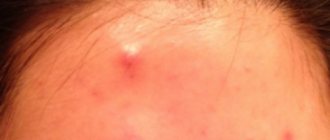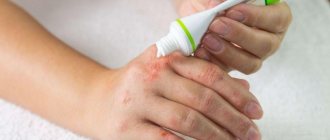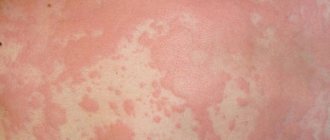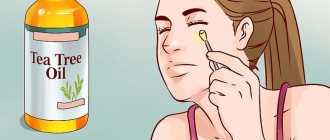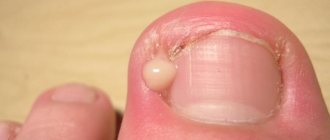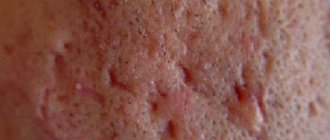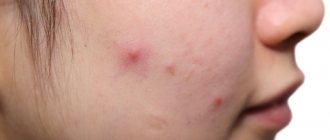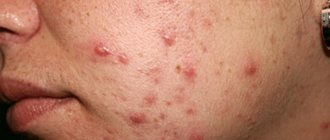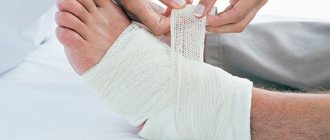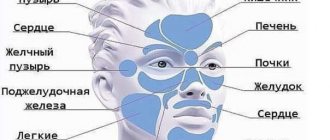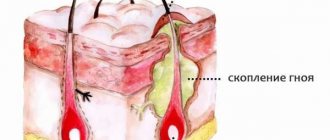Acne is the most common dermatological disease, from which no one is immune. Various factors can influence the appearance of acne. When inflammation occurs in the affected area, pain may occur. In order for quick relief to occur, it is important to know how to draw pus out of a pimple. After it breaks through, all unpleasant symptoms disappear and the process of tissue regeneration begins. Medications and folk remedies will tell you how to speed up this process.
Acne is a common problem
Introduction
The abscess must mature - have you ever wondered what this means in practice? Maturation indicates the formation of a purulent core that appears in the duct of the sebaceous gland.
The reason for its appearance is infection and the onset of the inflammatory process. The duration of ripening can vary, from several days to a month. Throughout this period, pain persists.
Trying to squeeze out abscesses as they mature is useless, unpleasant and even dangerous.
Not only will a new rod “come out” in the same place after 2-5 days, and the extraction process itself will cause severe pain, there is a risk of injuring the skin and reinfecting the wound.
Using some means, you can speed up the maturation of the abscess and remove the pain syndrome, as well as eliminate redness and ensure rapid healing of the open wound after the rod comes out. These include drugs for external use - antibiotics and anti-inflammatory ointments.
Several traditional medicines are a good alternative.
How to pull out a pimple at home
When a subcutaneous pimple with purulent contents appears on the body, the fight against it can drag on for weeks or even a month.
Most often, such problematic formations appear in places where the most sebaceous glands are located - on the chin, nose, forehead and back.
Normally, secretions are constantly secreted through the sebaceous glands, but when clots appear, the duct becomes clogged and inflammation develops.
At first, a red, seemingly harmless pimple appears, but after a few days it turns into a deep, painful abscess.
Many reasons can lead to such skin defects. Let's look at how to pull out a deep pimple and do it as safely as possible.
Ointments for external treatment of ulcers
The group of antibiotics used to treat purulent acne is small. Such drugs allow:
- quickly pull the shallow rod out;
- completely destroy deep ulcers (without the rod coming out);
- reduce the number of harmful microorganisms that cause inflammation;
- the wound formed at the site of the pimple heals without a trace.
The duration of antibiotic treatment ranges from 14 to 30 days on average; in some cases, repeated treatment is prescribed. However, using them without prior consultation with a doctor is dangerous, since powerful drugs destroy both harmful and beneficial microorganisms.
This group includes Metrogyl and Metrodinazole, Tyrosur, Baziron, etc.
Complex multicomponent preparations are also used to eliminate ulcers. In addition to the antibiotic, they contain anti-inflammatory and wound-healing substances. The cost of such drugs is surprisingly affordable, and they do not require a prescription when purchased.
NOTE!
To quickly get rid of blackheads, acne and pimples, as well as to rejuvenate your facial skin, we recommend that you familiarize yourself with this effective remedy .
Find out more...
Levomekol
Prominent representatives of the group of combined medications are Levomekol cream and ointment, which draw out all the pus from the wound in a few days. In addition, the product disinfects the skin and eliminates redness.
After 8-10 days (with 2 applications per day), a barely noticeable light pink mark will remain at the site of the abscess.
The main advantages of lekomekol are the acceleration of the formation of a purulent core and the suspension of the inflammatory process.
Special devices for squeezing out pustules
Cosmetologists recommend facial cleansing and removal of mature pimples in beauty salons. The specialist will offer several options for how to pull out a pimple effectively and painlessly.
- Instruments with a Vidal needle are used if the patient does not know how to remove pus from a deep subcutaneous abscess. This is a metal handle with threads on both sides. Devices in the form of a needle or loop are screwed on (removed) at the discretion of the cosmetologist. Before pulling out the pus from the pimple, it is pierced with a needle, and the contents are carefully removed using a nozzle that resembles a loop.
- Spoon Uno. This device resembles a spoon with a small hole in the middle. Using it, pimples with white heads are removed. The middle of the device (with a hole) presses on the problem area. And with a sliding movement to the side, the extracted contents of the formation are captured and left in the spoon.
These tools can be used to clean leather at home. The main thing is to maintain sterility - wash your hands with soap and disinfect the problem area and equipment.
Ichthyol ointment
A remedy that has been successfully used for decades to treat ulcers and boils is ichthyol ointment, made from petroleum jelly. It has a pronounced anti-inflammatory and antiseptic effect, quickly penetrates into the middle and deep layers of the dermis.
This drug is used to eliminate large, deep ulcers, the maturation of which under normal conditions will be very long and painful. Ichthyol is also useful in cases where other tried anti-acne remedies have failed.
The drug is applied to previously cleansed skin, to the head of the purulent rod and the reddened skin around it. After 1.5-2 hours, the remaining ointment can be removed with a damp cotton swab, otherwise the risk of getting a skin burn increases.
An important advantage of ichthyol ointment is the prevention of the formation of scars at the site of a pimple. Disadvantages include:
- presence of a pungent odor;
- contraindications (allergy to the components of the product, use of iodide salt or alkaloids).
For the first few days, treatment of ulcers is carried out once a day, then once every 2 days.
How to draw pus out of a pimple using folk remedies
Adherents of traditional medicine are probably wondering: how to pull out a pimple using natural remedies?
It turns out that the problem of internal ulcers is also effectively dealt with by some medicinal plants and other products that can be easily found at home or in the garden.
- You need to take aloe pulp and apply it to the inflamed area.
- Use a piece of fabric-based adhesive tape to secure such a compress for several hours or, even better, overnight.
To get rid of ulcers on the skin using folk remedies. Regular onions and aloe produce results no worse than imported drugs. Effective home recipes for drawing out old pus from a wound are presented below.
The flower is used to treat skin wounds. The plant has antiseptic properties and reduces typical symptoms of inflammation. Aloe is able to draw out purulent masses from deep and superficial layers. The abscess opens 2-3 days after regular bandaging.
For the compress you need a whole leaf of the plant, from which the protective film is removed. The plant is applied to the area of skin with pus, fixed with gauze or bandage. The procedure is carried out 2 times a day. The course of treatment is 3 days. If aloe fails to draw out the white pus, other types of compresses are used. The use of pharmaceutical drugs is added to the procedure.
The baked vegetable can be applied to the abscess to draw out the white pus from the wound. The healing onion for the skin is prepared in the oven, in a frying pan or in the microwave. The fruit is cut in half and placed in a heating device for 10 minutes. In the oven it bakes 6-7 at 180 degrees. For cooking in a frying pan, do not use vegetable oil or animal fat. The two halves are placed on a hot surface and baked over low heat for 10 minutes.
Need advice from an experienced doctor? Get a doctor's consultation online. Ask your question right now.
Ask a free question
After cooling, the onion is applied to the abscess with pus. The baked vegetable is fixed with circular rounds of bandage. After 2-3 hours, the bandage on the skin is changed. Onions can draw out white pus in a short period of time.
If it is not possible to bake the onion, it is boiled. After cooking and cooling, apply compresses.
Garlic
Garden garlic is used to treat mild boils and can draw out liquid pus from the affected dermis in 2-3 days. The main advantage of the plant is its ability to disinfect the surface of the skin.
To draw out and get rid of pus using garlic, you need to peel its head and bake it in the oven. The prepared raw materials are mixed with grated laundry soap and heated in the microwave. The mass is converted into a cake. When warm, it is applied to the area of skin with pus. After 4 hours, the garlic cake is replaced with a new one. The product will be able to draw out the contents if you use it 4-5 times a day.
To get rid of pus, use the following effective folk remedies:
- Cabbage leaves. Inhibits the development of abscess, boil, and wen. They can draw out infected contents from superficial skin wounds. When the pus drains, inflammation decreases. Cabbage leaves are washed with clean water. They need to be mashed first to release the juice. Apply to the wound and secure with a bandage on top. Compresses on the skin are changed 2 times a day.
- Potatoes with beets. Vegetable pulp effectively draws pus from the wound. The fruits are grated and laid out on top of gauze. In this form it is applied to the sore spot.
Folk remedies are effective for treating mild cases of pathology. In severe situations, in order to draw out the old pus, you will need to use medications and surgery.
If the abscess is located on the skin of the face, Vishnevsky's liniment and ichthyol ointment may not be suitable. They have an unpleasant odor. Being close to the nose causes discomfort.
To draw out hard pus from a pimple, apply aloe, compresses with salt, and Levomekol gel. Under the influence of the funds, the bubble matures and breaks through. They are not dangerous to the body and rarely cause side effects.
To treat acne on the skin, you can use drugs from the pharmacy: Zinerit, Skinoren. Both drugs have bactericidal and anti-inflammatory properties. They are easy to apply and work quickly.
In addition to pharmaceuticals that are expensive and have many contraindications, there are many effective folk recipes. You can pull pus out of a pimple using:
- Calendula tinctures – alcohol tincture of calendula dries the skin, has an anti-inflammatory and antiseptic effect. To get rid of a pimple, you need to soak a cotton swab in the tincture, apply it to the area of inflammation and leave it overnight. Already in the morning, you will be able to see drawn-out pus on the tampon; after this, the site of inflammation should be treated with a disinfectant to avoid further inflammation.
- Aloe - this medicine not only perfectly draws out pus, but also prevents the development of inflammation and accelerates tissue healing. To get rid of a purulent pimple, you need to cut a fresh leaf of the plant in half, apply the pulp to the inflammation, cover it with an adhesive bandage and leave for several hours, preferably overnight. If the pimple is located too deep, 1 to 3 treatments in a row may be needed.
- Potatoes – regular raw potatoes can help in cases where other anti-inflammatory drugs are not available. Due to the high starch content, the potato mass will help draw out pus and reduce the inflammation process. To do this, you need to grate a small potato and apply the mass to the site of inflammation; you can apply a gauze bandage on top or secure it with a cotton pad and adhesive tape. This compress is left overnight or worn without removing for several hours.
- St. John's wort infusion – 1 tbsp. l. dry herbs pour 1 tbsp. boiling water, leave for 15 minutes, filter and use to prepare lotions. St. John's wort infusion has an anti-inflammatory and antibacterial effect, and also has tanning properties, which helps reduce irritation. To draw out pus, a cotton pad moistened with St. John's wort infusion is placed on a purulent pimple and left overnight, secured with an adhesive plaster.
All of the above remedies can only help in the treatment of small, “immature” acne on the skin. In all other cases, you must first seek advice from a cosmetologist or surgeon, who can accurately assess the condition of the skin and prescribe more effective treatment.
Popular Topics:
- Body care Proper daily body skin care at home: recipes with video It is necessary to organize this way...
- Pore mask Enlarged pores on the face can cause us a lot of discomfort. The surface of the skin with large pores looks...
- Wrinkles around the eyes As a funny person with a light disposition, it is easy to recognize by the characteristic web of wrinkles around the eyes - so...
- Lemon for facial skin Daily facial skin care does not necessarily require large expenditures; often the ideal components for toner…
- Spinach sauce Recipe: Spinach sauce Spinach is a unique type of green that has good taste. Also he...
Poll: When did your acne appear? (Number of votes: 4295)
I've been suffering all my life
It's been a couple of years now
About a few months
Recently
To vote, click on the desired answer.Results
- Benzoyl Peroxide: There are many non-contact benzoyl peroxide compounds available. For moderate acne, use a solution of at least 5% benzoyl peroxide. You should not use this solution near an open wound or mucous membrane, such as inside the nose or mouth.
- Antibiotics: Your doctor may recommend an antibiotic such as minocycline and doxycycline to treat bacteria associated with acne as well as draw pus from the pimple.
- Systemic medications: Systemic medications and vitamin A-derived products such as isotretinoin are usually reserved for severe cases of cystic suppurative acne. These products are quite effective at drawing pus out of a pimple, but are associated with extensive side effects that should be analyzed for skin effects. monitored by your attending physician.
Acne, especially pimples, can be particularly painful in some cases. Appropriate and quick treatment can begin with non-steroidal medications such as ibuprofen or naproxen.
Various acne treatments can have complex and serious interactions. For example, antibiotics may reduce the effectiveness of female oral contraceptives. Sun sensitivity is more likely to cause side effects on the skin when taking certain antibiotics combined with vitamin A and non-steroidal anti-inflammatory drugs.
Vitamins
Acne is known to respond positively to supplementation with niacin (100 mg, three times daily) and adding more vitamin A foods to the diet. 400 mg of vitamin E consumed per day can also work wonders. You can also take 50 mg of therapeutic zinc in tablet or capsule form (three times a day).
Fenugreek
The leaves of this vegetable can be used to create a healthy paste, which is then applied to the face before you go to bed every night. In the early morning, the paste should be washed off with warm water. Pimples, especially blackheads, can be treated with this home remedy.
Orange peeling
When orange peel is crushed and combined with water, an effective home remedy for acne is created. Such a remedy is applied to the affected areas directly for the purpose of drawing out the pus from the pimple.
Apply lemon juice to pimples 2 times a day for 1 week, and you will reduce their size and draw pus from the pimple.
Garlic
If you rub raw garlic on the problem areas several times a day, you can clear the pus from the pimple from your skin. You can also eat three pieces of raw garlic once a day for a month to see the results of your treatment in just a week. Garlic seeds purify the blood. which helps keep acne, including purulent inflammation, under strict lock and key.
A useful herbal remedy for acne is to mix one teaspoon of coriander juice combined with a pinch of turmeric powder. Every night, after washing your face thoroughly, apply the juice for an effective home remedy to draw out the pus from the pimple and thus treat acne. Mint juice can also replace coriander for this homemade acne treatment.
- Calendula tinctures – alcohol tincture of calendula dries the skin, has an anti-inflammatory and antiseptic effect. To get rid of a pimple, you need to soak a cotton swab in the tincture, apply it to the area of inflammation and leave it overnight. Already in the morning, you will be able to see drawn out pus on the tampon; after this, the site of inflammation must be treated with a disinfectant to avoid further inflammation;
- Aloe - this medicine not only perfectly draws out pus, but also prevents the development of inflammation and accelerates tissue healing. To get rid of a purulent pimple, you need to cut a fresh leaf of the plant in half, apply the pulp to the inflammation, cover it with an adhesive bandage and leave for several hours, preferably overnight. If the pimple is located too deep, 1 to 3 procedures in a row may be needed;
- Potatoes – regular raw potatoes can help in cases where other anti-inflammatory drugs are not available. Due to the high starch content, the potato mass will help draw out pus and reduce the inflammation process. To do this, you need to grate a small potato and apply the mass to the site of inflammation; you can apply a gauze bandage on top or secure it with a cotton pad and adhesive tape. This compress is left overnight or worn without removing for several hours;
- St. John's wort infusion - 1 tbsp of dry herb, pour 1 tbsp of boiling water, leave for 15 minutes, filter and use to prepare lotions. St. John's wort infusion has an anti-inflammatory and antibacterial effect, and also has tanning properties, which helps reduce irritation. To draw out pus, a cotton pad moistened with St. John's wort infusion is placed on a purulent pimple and left overnight, secured with an adhesive plaster.
Garlic
Liniment Vishnevsky
Widely known for its unique properties, Vishnevsky ointment is useful in the treatment of many diseases, including purulent rashes on the face or body.
Means:
- has a local irritant effect (increases blood circulation);
- antiseptic effect helps destroy harmful bacteria (on the surface and deep in the skin);
- accelerates metabolic and regeneration processes;
- promotes the rapid release of the purulent core to the outside.
To remove small ulcers, it is enough to treat the skin 1-2 times a day. To remove a large purulent core, you will need to make an application.
To do this, apply a thick layer of ointment to a small piece of gauze or a cotton pad, and then attach it with a band-aid over the pimple. It is best to do this before going to bed, and in the morning wash with clean water, removing any remaining drug.
The only drawback of Vishnevsky ointment is its unpleasant aroma. But if you endure, the results are worth it.
Reasons for appearance
Blockage of the excretory duct of the sweat or sebaceous gland provokes an inflammatory process that develops due to the active activity of pathogenic agents.
Purulent internal acne in the subcutaneous fat most often occurs due to blockage and inflammation of the excretory duct of the sebaceous or sweat gland. When the excretory duct is blocked, sebum and epithelial particles accumulate in it, which become an ideal environment for the proliferation of pathogenic microorganisms.
The causes of purulent acne on the skin may be:
- Metabolic disorder - excessive sebum secretion causes blockage of the excretory ducts and becomes the most common cause of acne on the skin.
- Hormonal changes - an imbalance of sex hormones in the body of adolescents, pregnant women and girls during menstruation leads to disruption of the formation and excretion of sebum and the formation of acne.
- Lack of vitamins and poor nutrition - a lack of nutrients and the habit of oversaturating your diet with sweets, flour and processed foods leads to the skin becoming too dry, the intestines becoming clogged, and toxins are “removed” through the skin, polluting it and causing acne.
- Improper skin care - in the absence of regular and appropriate care and the use of inappropriate cosmetics, the skin of the face and body becomes too dry or oily, which can also cause inflammation and the appearance of pus.
It is better to pull pus out of a pimple before it “ripes” and completely comes to the surface. To do this, you can use special pharmaceutical products or use one of the many folk recipes.
They destroy pathogenic bacteria and speed up healing. Antibacterial agents help get rid of pus, but do not draw it out, so the time to get rid of acne can range from several days to several months.
- Baziron Ac - has a powerful antibacterial effect, has an anti-inflammatory effect, reduces sebum synthesis and improves microcirculation processes in tissues. Apply the gel to previously cleansed skin 2 times a day, after morning and evening washing and leave until dry. The course of treatment can last up to several weeks, so this remedy cannot be classified as an “emergency”.
- Zinerit is a complex product containing an antibiotic and zinc. It has a bacteriostatic, wound-healing and anti-inflammatory effect. Apply the product 2 times a day, morning and evening, to cleansed skin without rinsing. The course of treatment is up to 10 days.
- Streptocide liniment is an antimicrobial agent used for large affected areas. It is applied in a thin layer to the skin of the face or body or on a cotton pad, which is applied to pimples. Treatment is carried out several times a day, results become noticeable after 2-3 days.
Festive video recipe:
- Liniment or Vishnevsky ointment - has an antiseptic and irritating effect, due to which it quickly draws out pus from deep, subcutaneous pimples. Vishnevsky's ointment or liniment softens the outer layers of the epithelium, penetrating deep into the subcutaneous fat, destroying microbes at the site of inflammation and increasing blood circulation in the affected area, which accelerates the removal of purulent exudate and tissue healing.
- Ichthyol ointment also has an anti-inflammatory and bactericidal effect, accelerating the removal of pus from acne. It penetrates deeply into the skin, causing the death of microorganisms and stimulating the release of purulent secretion.
- Skinoren, Azogel - has an antimicrobial and pore-narrowing effect. The gel belongs to retinoids, modern, expensive and highly effective drugs. It clogs the excretory ducts of the sebaceous glands and hair follicles, which leads to a temporary suspension of their functions. The gel is rubbed into the skin 2-3 times a day or applied generously to the site of inflammation for several weeks.
- Bodyaga - has a mechanical irritating effect on the source of inflammation. This is an affordable remedy that causes increased blood circulation at the site of application, due to which the pus is quickly drawn out of the pimple, and the tissues are regenerated.
- Salicylic acid – has an antiseptic and keratolytic effect. Penetrating deep into the skin, it destroys pathogens and accelerates the process of exfoliation of dead epithelial cells. Salicylic ointment is applied pointwise - only to areas of inflammation that have been previously cleaned with hydrogen peroxide or chlorhexidine. The skin is treated 3 times a day until the pustules completely disappear.
The causes of purulent acne on the skin may be:
- Metabolic disorders - excessive sebum secretion causes blockage of the excretory ducts and becomes the most common cause of acne on the skin;
- Hormonal changes - an imbalance of sex hormones in the body of adolescents, pregnant women and girls during menstruation leads to disruption of the formation and excretion of sebum and the formation of acne;
- Lack of vitamins and poor nutrition - lack of nutrients and the habit of oversaturating your diet with sweets, flour and processed foods leads to the skin becoming too dry, the intestines becoming clogged, and toxins are “removed” through the skin, polluting it and causing acne;
- Improper skin care - in the absence of regular and appropriate care and the use of inappropriate cosmetics, the skin of the face and body becomes too dry or oily, which can also cause inflammation and the appearance of pus.
Acne is a polyetiological disease and the leading factor is genetic predisposition. In addition, certain exogenous and endogenous causes contribute to the appearance of comedones.
Some external factors can trigger skin rashes:
- Abuse of cosmetic products containing fats. They close pores and increase the formation of comedones, which further aggravates the disease.
- Hot and humid climate. In this climate, the functioning of the sebaceous glands increases, which causes the appearance of a large number of rashes on the skin.
- Bright rays of the sun and ultraviolet radiation. Bright sunlight has a negative effect on the skin and provokes the appearance of new acne on the skin.
- Work in hazardous conditions involving interaction with toxic and polluting substances. Acne mainly appears through the development of hyperkeratosis of the skin and hair follicles.
- Squeezing pimples. Mechanical injury, provoked by external influences, ends with the spread of the inflammatory process to nearby tissues. In the absence of sterility, infection penetrates into the wounds, which further aggravates the disease.
- Excessive cleanliness. Excessive hygiene and abuse of antiseptics can worsen the condition of the skin.
The internal causes of acne include the following factors:
- changes in the body's hormonal levels;
- disruptions in the functioning of the endocrine system;
- pathologies of the gastrointestinal tract;
- violation of the microflora of the skin;
- frequent stressful situations;
- malfunctions of the immune system.
Streptocide ointment
Streptocide cannot be classified as an antibiotic. But it has a pronounced anti-inflammatory, analgesic and antibacterial effect, although it does not accelerate the release of pus. This ointment is useful for small ulcers accompanied by severe redness of the surrounding skin.
The product is applied over the rash at night, or compresses are made from it. A reduction in hyperemia becomes noticeable already on the 2nd day of use, however, to consolidate the results, it is necessary to continue treating the skin for 5-7 days.
